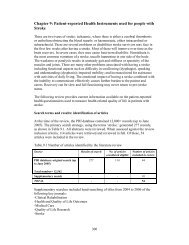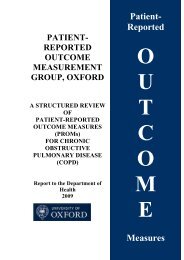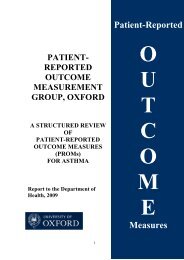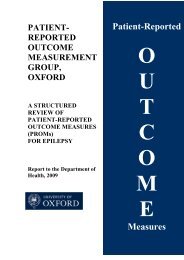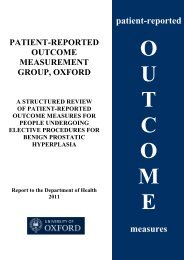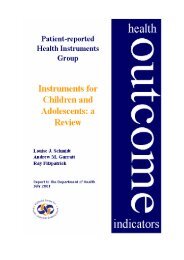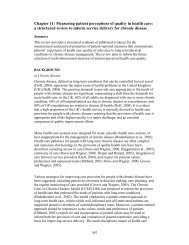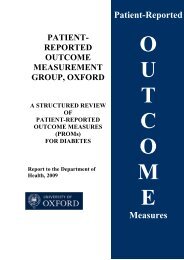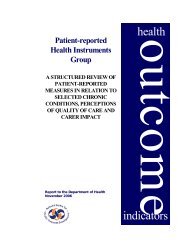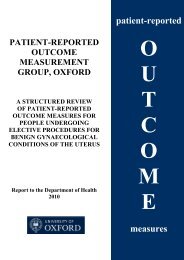2010 review - Patient-Reported Outcomes Measurement - University ...
2010 review - Patient-Reported Outcomes Measurement - University ...
2010 review - Patient-Reported Outcomes Measurement - University ...
Create successful ePaper yourself
Turn your PDF publications into a flip-book with our unique Google optimized e-Paper software.
5. SUMMARY AND RECOMMENDATIONS<br />
Table 2 provides a summary of the evidence of psychometric properties for the instruments<br />
identified in this <strong>review</strong>. Table 3 shows the HRQoL domains covered by each PROM. A<br />
summary of their content and scoring method can be found in Appendix B.<br />
Preference-based measures<br />
Amongst the preference-based measures, the EQ-5D was the only instrument with sufficient<br />
evidence to warrant consideration (seven studies; five with UK samples). It demonstrated<br />
validity and responsiveness with both CABG and PCI samples. However, there was mixed<br />
evidence regarding its acceptability to patients, as reflected in response rates. Where a utility<br />
is required, the EQ-5D is the most appropriate measure to use.<br />
Generic measures<br />
Amongst the generic, multidimensional instruments <strong>review</strong>ed, the SF-36 had by far the most<br />
evidence supporting its use with the ECP population (39 studies, eight with UK samples).<br />
The SF-36 appears to work well in both types of procedure, although there were many more<br />
studies with patients undergoing CABG compared with PCI. Evidence for reliability, validity,<br />
responsiveness, and acceptability to patients was substantial; however, one study reported<br />
ceiling effects, and some studies had low response rates. If the aim is to compare ECP<br />
patients with other disease populations, the SF-36 may be considered; however, if used alone,<br />
it may not be sensitive to subtle changes within this particular group.<br />
Condition-specific measures<br />
Of the condition-specific instruments identified, the Seattle Angina Questionnaire had by far<br />
the most evidence supporting its use with patients undergoing CABG or PCI (22 studies),<br />
demonstrating most of the important psychometric properties. It has been extensively applied<br />
in both types of procedure, and with UK patient samples (five studies). However, it was<br />
developed for the assessment of CAD in general, and could be said to lack some items that<br />
are important for patients undergoing cardiac surgery. In particular, psychological well-being<br />
appears to be an important predictor of recovery, and there is evidence that cardiac<br />
procedures, particularly CABG, may have long-term effects on cognitive functioning. The<br />
SAQ does not include cognitive functioning, and does not fully cover the psychosocial<br />
domain.<br />
Although there is as yet relatively little evidence to support its use (five studies, all UK), the<br />
Coronary Revascularisation <strong>Outcomes</strong> Questionnaire, recently developed in the UK, is<br />
promising. The CROQ includes both psychosocial and cognitive functioning, as well as<br />
surgery-specific items. Some of the other measures <strong>review</strong>ed, such as the Cardiac Symptom<br />
Survey and the Heart Surgery Symptom Inventory, may also prove valuable if further<br />
evidence emerges. Choice of instrument may be influenced by whether short- and medium-,<br />
or longer-term outcomes are the focus of investigation. If short- and medium-term outcomes<br />
are the main object of attention, one of these surgery-specific measures could be the<br />
instrument of choice.<br />
The Duke Activity Status Index has considerable merit as a measure of cardiac patients’<br />
capacity to engage in activities which are important to their QoL. It has greater reliability and<br />
sensitivity than the NYHA and CCS classification systems, and stronger psychometric<br />
properties than the Specific Activity Scale; it has also been widely used with patients<br />
33



